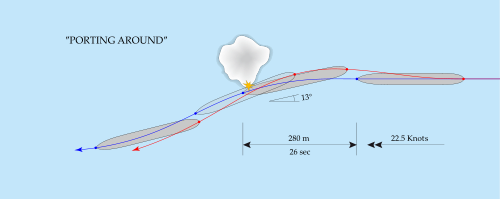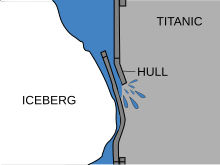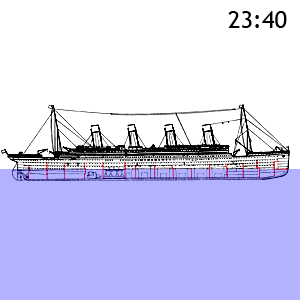
The creepy true prediction 14 years before the Titanic made its maiden voyage
Writer Morgan Robertson penned a novella in 1898 called ‘Futility, Or the Wreck of the Titan’.
In the story, an ocean liner called the Titan, which was the largest ship ever made, hit an iceberg and sank.
The novella was written before the RMS Titanic was designed, but the Titan was similar in size – 882ft 9in (269 m) compared to Titanic’s 800ft (244 metres).
Both ships sank after hitting an iceberg in the North Atlantic Ocean and neither had enough lifeboats for passengers.
In his story, Mr Robertson calls Titan ‘unsinkable’, which was also used in promotion for the Titanic’s maiden voyage.
More than half of Titanic’s 2,200 passengers and crew died compared to half of Titan’s 2,500 passengers and crew.
The Titanic sank in 1912, 14 years later.
As Titanic approached her fatal crash, most passengers had gone to bed and command of the bridge had passed fromSecond Officer Charles Lightoller to First Officer William Murdoch. Lookouts Frederick Fleet and Reginald Lee were occupying the crow’s nest 29 metres (95 ft) above the deck. The air temperature had fallen to near freezing and the ocean was completely calm. Colonel Archibald Gracie, one of the survivors of the disaster, later wrote that “the sea was like glass, so smooth that the stars were clearly reflected.” It is now known that such exceptionally calm water is a sign of nearby pack ice.
Although the air was clear, there was no moon, and with the sea so calm, there was nothing to give away the position of the nearby icebergs; had the sea been rougher, waves breaking against the icebergs would have made them more visible. Because of a mix-up at Southampton the lookouts had no binoculars; but reportedly binoculars would not have been effective in darkness which was total except for starlight and the ship’s own lights. The lookouts were nonetheless well aware of the ice hazard, as Lightoller had ordered them and other crew members to “keep a sharp look-out for ice, particularly small ice and growlers”.

Diagram of Titanic ’s course at the time of the collision with the iceberg.
(Blue: path of bow. Red: path of stern.)
At 23:30, Fleet and Lee noticed a slight haze on the horizon ahead of them, but did not make anything of it. Nine minutes later, at 23:39, Fleet spotted an iceberg in Titanic ’s path. He rang the lookout bell three times and telephoned the bridge to inform Sixth Officer James Moody. Fleet asked “Is there anyone there?” Moody replied, “Yes, what do you see?” Fleet replied: “Iceberg, right ahead!” After thanking Fleet, Moody relayed the message to Murdoch, who ordered Quartermaster Robert Hichens to change the ship’s course. Murdoch is generally believed to have given the order “Hard a’starboard” which would result in the ship’s tiller being moved all the way to starboard (the right side of the ship) in an attempt to turn the ship to port (left). He also rang “Full Astern” on the ship’s telegraphs.
According to Fourth Officer Joseph Boxhall, Murdoch told Captain Smith that he was attempting to “hard-a-port around [the iceberg]”, suggesting that he was attempting a “port around” manoeuvre – to first swing the bow around the obstacle, then swing the stern so that both ends of the ship would avoid a collision. There was a delay before either order went into effect; the steam-powered steering mechanism took up to 30 seconds to turn the ship’s tiller, and the complex task of setting the engines into reverse would also have taken some time to accomplish. Because the centre turbine could not be reversed, both it and the centre propeller, positioned directly in front of the ship’s rudder, were simply stopped. This reduced the rudder’s effectiveness, therefore impairing the turning ability of the ship. Had Murdoch simply turned the ship while maintaining her forward speed, Titanic might have missed the iceberg with feet to spare.
In the event, Titanic ’s heading changed just in time to avoid a head-on collision, but the change in direction caused the ship to strike the iceberg with a glancing blow. An underwater spur of ice scraped along the starboard side of the ship for about seven seconds; chunks of ice dislodged from upper parts of the berg fell onto her forward decks. A few minutes later, all of Titanic ’s engines were stopped, leaving the ship facing north and drifting in the Labrador Current.
Effects of the collision :-

The iceberg buckled the plates, popping rivets and damaging a sequence of compartments. Contrary to widespread assumption, the iceberg did not slice the hull.
The impact with the iceberg was long thought to have produced a huge opening inTitanic ’s hull, “not less than 300 feet (91 m) in length, 10 feet (3.0 m) above the level of the keel”, as one writer later put it. However, at the British enquiry following the accident, Edward Wilding (chief naval architect for Harland and Wolff), calculating on the basis of the observed flooding of forward compartments forty minutes after the collision, testified that the area of the hull opened to the sea was “somewhere about 12 square feet”. He also stated that “I believe it must have been in places, not a continuous rip”, but that the different openings must have extended along an area of around 300 feet, to account for the flooding in several compartments. However, the official findings of the enquiry simply state that the damage extended about 300 feet, and hence many subsequent writers followed this statement. Modern ultrasound surveys of the wreck have found that the damage consisted of six narrow openings in an area of the hull covering only about 12 to 13 square feet (1.1 to 1.2 m2) in total. According to Paul K. Matthias, who made the measurements, the damage consisted of a “series of deformations in the starboard side that start and stop along the hull … about 10 feet [3.0 m] above the bottom of the ship.”
The gaps, the longest of which measures about 39 feet (12 m) long, appear to have followed the line of the hull plates. This suggests that the iron rivets along the plate seams snapped off or popped open to create narrow gaps through which water flooded. An engineer from Titanic ’s builders, Harland and Wolff, suggested this scenario at the British Wreck Commissioner’s inquiry following the disaster but his view was discounted. Titanic ’s discoverer Robert Ballard has commented that the assumption that the ship had suffered a massive breach was “a byproduct of the mystique of theTitanic. No one could believe that the great ship was sunk by a little sliver.” Faults in the ship’s hull may have been a contributing factor. Recovered pieces of Titanic ’s hull plates appear to have shattered on impact with the iceberg, without bending.
The plates in the central 60% of the hull were held together with triple rows of mild steel rivets, but the plates in the bow and stern were held together with double rows of wrought iron rivets which were – according to materials scientists Tim Foeckeand Jennifer McCarty – near their stress limits even before the collision. These “Best” or No. 3 iron rivets had a high level of slag inclusions, making them more brittle than the more usual “Best-Best” No. 4 iron rivets, and more prone to snapping when put under stress, particularly in extreme cold. But Tom McCluskie, a retired archivist of Harland & Wolff, pointed out that Olympic, Titanic’s sister ship, was riveted with the same iron and served without incident for nearly 25 years, surviving several major collisions, including being rammed by a British cruiser. The Olympic even rammed and sank the U-boat U-103 with her bow. Thereby, the stem was twisted and hull plates on the starboard side were buckled without impairing the hull’s integrity.
Above the waterline, there was little evidence of the collision. The stewards in the first class dining room noticed a shudder, which they thought might have been caused by the ship shedding a propeller blade. Many of the passengers felt a bump or shudder but did not know what it was. Those on the lowest decks, nearest the site of the collision, felt it much more directly. Engine Oiler Walter Hurst recalled being “awakened by a grinding crash along the starboard side. No one was very much alarmed but knew we had struck something”. Fireman George Kemish heard a “heavy thud and grinding tearing sound” from the starboard hull.
The ship began to flood immediately, with water pouring in at an estimated rate of 7 long tons (7.1 t) per second, fifteen times faster than it could be pumped out. Second Engineer J. H. Hesketh and Leading Stoker Frederick Barrett were hit by a jet of icy water in No. 6 boiler room and escaped just before the room’s watertight door closed. This was an extremely dangerous situation for the engineering staff; the boilers were still full of hot high-pressure steam and there was a substantial risk that they would explode if they came into contact with the cold seawater flooding the boiler rooms. The stokers and firemen were ordered to reduce the fires and vent the boilers, sending great quantities of steam up the funnel venting pipes. They were waist-deep in freezing water by the time they finished their work.

Annotated diagram of RMS Titanic showing the arrangement of the bulkheads. The areas of damage are shown in green. The compartments in the engineering area at the bottom of the ship are noted in blue. The scale’s smallest unit is 10 feet (3.0 m) and its total length is 400 feet (120 m).
Titanic ’s lower decks were divided into sixteen compartments. Each was separated from its neighbour by a bulkhead running the width of the ship; there were fifteen bulkheads in all. Every bulkhead extended at least to the underside of E Deck, nominally one deck, or about 11 feet (3.4 m), above the waterline. The two nearest the bow and the six nearest the stern went one deck further up.
Each bulkhead could be sealed by watertight doors. The engine rooms and boiler rooms on the tank top deck had vertically closing doors that could be controlled remotely from the bridge, lowered automatically by a float if water was present, or closed manually by the crew. These took about 30 seconds to close; warning bells and alternate escape routes were provided so that the crew would not be trapped by the doors. Above the tank top level, on the Orlop Deck, F Deck and E Deck, the doors closed horizontally and were manually operated. They could be closed at the door itself or from the deck above.
Although the watertight bulkheads extended well above the water line, they were not sealed at the top. If too many compartments were flooded, the ship’s bow would settle deeper in the water, and water would spill from one compartment to the next in sequence, rather like water spilling across the top of an ice cube tray. This was what happened to Titanic, which had suffered damage to the forepeak tank, the three forward holds and No. 6 boiler room, a total of five compartments. Titanic was only designed to float with any two compartments flooded, but it could remain afloat with certain combinations of three or even four compartments (the first four) open to the ocean. With five compartments, however, the tops of the bulkheads would be submerged and the ship would continue to flood.

Animation showing the sequence of Titanic ’ssinking
Captain Smith felt the collision in his cabin and came immediately to the bridge. Informed of the situation, he summoned Thomas Andrews,Titanic ’s builder, who was among a party of engineers from Harland and Wolff observing the ship’s first passenger voyage. The ship was listing five degrees to starboard and was two degrees down by the head within only a few minutes of the collision. Smith and Andrews went below and found that the forward cargo holds, the mailroom and the squash court were flooded, while No. 6 boiler room was already filled to a depth of 14 feet (4.3 m). Water was spilling over into No. 5 boiler room, and crewmen there were battling to pump it out.
Within only 45 minutes of the collision, at least 13,500 long tons (13,700 t) of water had entered the ship. This was far too much forTitanic ’s ballast and bilge pumps to handle; the total pumping capacity of all the pumps combined was only 1,700 long tons (1,700 t) per hour. Seawater was pouring into Titanic 15 times faster than it could be pumped out. Andrews informed the captain that the first five compartments were flooded, and therefore Titanic was doomed. By his estimate, she could remain afloat for no longer than about two hours.
From the time of the collision to the moment of her sinking, at least 35,000 long tons (36,000 t) of water flooded into Titanic, causing her displacement to nearly double from 48,300 long tons (49,100 t) to over 83,000 long tons (84,000 t). The flooding did not proceed at a constant pace, nor was it distributed evenly throughout the ship, due to the configuration of the flooded compartments. Her initial list to starboard was caused by asymmetrical flooding of the starboard side as water poured down a passageway at the bottom of the ship. When the passageway was fully flooded, the list corrected itself but the ship later began to list to port by up to ten degrees as that side also flooded asymmetrically.
Titanic ’s down angle altered fairly rapidly from zero degrees to about four and a half degrees during the first hour after the collision, but the rate at which the ship went down slowed greatly for the second hour, worsening only to about five degrees. This gave many of those aboard a false sense of hope that the ship might stay afloat long enough for them to be rescued. By 1:30, however, the sinking rate of the front section increased until Titanic reached a down angle of about ten degrees.
Originally posted 2015-07-20 05:44:53. Republished by Blog Post Promoter













